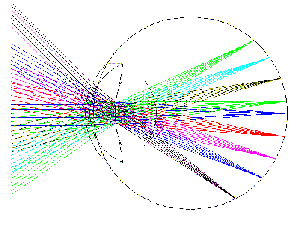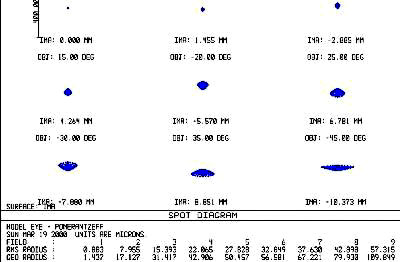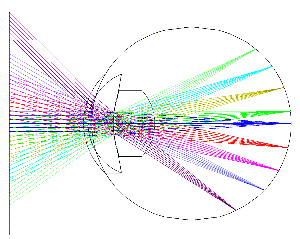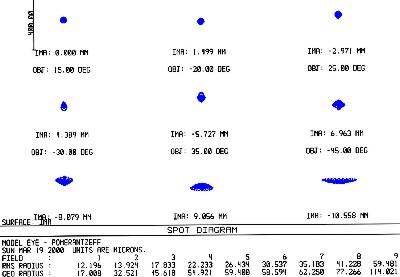(Click on underlined link to go to subject)
Chapter 1. Vision
System Design
Chapter 2. Biological Eye Designs
Chapter
3. Eye
Design
Illustrations
Chapter 4.
Eye
Reproduction
A.
General
requirements
1.
Optical,
computing and intelligence requirements
2.
Design
for eproduction
3.
Physical
development
requirements
B.
Optical
design and
integration
1.
Optical
design issues
2.
Programming
issues relative to probability
3.
Original
intelligence issues
C.
Design
control
1.
Control
of cell complexity
2. The
DNA
plan for control of cell integration
D. Questions and comments on evolution related to eye reproduction
Chapter
5. Optical
Systems
Design
Chapter
6. The Eye Designer
Related
Links
Appendix
A - Slide Show & Conference Speech by Curt Deckert
Appendix
B - Conference Speech by Curt Deckert
Appendix
C - Comments From Our Readers
Appendix
D - Panicked Evolutionists: The Stephen Meyer Controversy
Chapter 4
Section B
(Click on PICTURE IN TEXT to bring up LARGE PICTURE)
4. EYE REPRODUCTION
B.
Optical Design and Integration
1.
Optical Design issues
As previously noted in Sections II, both small compound insect eyes and
camera-type animal eyes include diverse advanced vision design. Eye
designs occur with material variations within different animal types
such as the use of different pigments to see different colors, as
compared to small variations of materials making up the human eyes.
Each eye design seems to be designed specifically for its application.
In the case of human eyes, the design seems to be constant for most
people, except for very limited pupil, iris, retina, and size
variations. For some people of farsighted and nearsighted conditions,
corrections arerequired,
while some animals may have limited sight because of similar defects.
See the following Figures regarding the critical nature of eye
design.
How do we account for overall
stability of each part of the eye?
The overall design complexity
of insect, animal, and human eye functions and construction requires
considerable data to describe them well enough to manufacture or
reproduce them. In recent years, we are finding out that DNA codes have
adequate data capacity to describe very detailed methodologies for
reproduction, integration, repair and functioning of complex vision
systems.
Material combinations and
shapes found in typical eyes are not likely to come together by chance
to form vision systems. Transparent optical cell materials,
manufactured within eye cells, have to be consistently variable over
the volume of a lens, thereby requiring complex programming and
assembly. Subtle variations of eye materials and configurations have to
be generated from genetic codes. This is based on considerations of
optimized optical design. Eye reproduction is an example of the
integration of a non-reducible system.
Commonality and order of many
creative designs in many eyes indicates themes of a single
designer/creator. Many scientists tend to choose common ancestry to
explain commonality. Designs done according to a number of similar
themes suitable for different creatures are like an optical designer
leaving signatures on each eye design. Consider the alternative of a
series of random beneficial accidents strung together over thousands or
even millions of years to present such a variety of reproducible eye
designs.
2. Programming issues related to probability
We are just now starting to
understand what eyes are able to do. All this is related to
intelligence and probability. Eyes by most mutations must be blind
eyes, just as dogmatic faith in beneficial mutations can be a blind
faith.
As we go way back in history, how
did
the reproduction process start?
The early concept planning,
designing, and programming must have had a beginning, and therefore a
designer. Reproduction had to be an integral part of the design. In
comparing natural eyes to man-made eyes, we find that natural eyes are
far more complex. This is basically because of precise light control,
limited space, complete interfacing with a brain, and variable material
construction requirements. These are all important but their capability
to repair and reproduce is what really sets natural eyes apart from
man-made eyes. Even today, total system design must take into account
the means of manufacturing and repair in the life cycle of a product.
Sizes, surfaces, shapes and
materials of eyes have to be programmed within precision tolerances for
all types of eyes. This is especially true of compound and camera eye
designs where eyes or eye segments operate close to optical diffraction
limitations (note section II). It is as if the optical designer
optimized the eye's shape for every specific application. The DNA code
for precise cell development is a key requirement for programmed eye
development. The original eye design has to be good, because there are
too many variables to make a case for design by chance.
How could this communication be
designed and programmed without outside intelligence?
If one takes the probability
of each necessary cell occurring, it approaches a near impossibility,
but putting an eye together with the cells as a given or starting point
also provides a near impossible probability.
Can anyone make a case for the low
probability of evolution of the reproduction process?
A constant chemical medium is
not the message. Particular chemicals must be intelligently programmed
into the DNA code array. There is plenty of proof that intelligent
people can communicate, design communication systems, and develop
technologies. This analogy with an intelligent creator will prove to
have realistic probabilities.
3.
Original intelligence issues
DNA programming of cells and
materials indicates that very high intelligence is necessary for the
total reproduction system to function. Darwin did not have a complete
theory that included detailed knowledge of eyes. And he certainly did
not have a good explanation for reproduction of complex eye designs.
Thus, it is probable that he knew very little about the complexity of
vision and its reproduction, as we know it today. Now it is possible to
grow parts of certain eyes such as compound insect eyes from some
existing cells, using genetic engineering technology. This is only
using the DNA plans as originally set forth in the original design.
Isn't evolutionary theory something like trying to explain the origin of an automated factory without allowing any intelligent engineers, designer's, and suppliers' involvement in its origin? What about its daily operation?
The question of how reproductive capability evolved without intelligence is a question that could lead to a belief in a master designer with unlimited intelligence. From my years of experience in building optical systems I believe, even if there were considerable time involved, there cannot be multiple high-resolution reproducible visual systems evolving by random mutation without a designer. Somehow the intelligent design part of the reproduction process had to be part of a master design plan, for each particular type of eye.
Where is measurable proof of the sources of intelligence and programming in evolution of eye reproduction?
We find considerable evidence of original programming and intelligence that provides evidence of an intelligent designer in the area of biological vision reproduction. Evidence of intelligent design could include knowledge available at birth, learning capability, light control, focusing control, ability to point the eye at a target, and the ability to track a specific moving object.
Questions for Discussion
Has evolution produced a creator, or did a creator with unlimited intelligence design and develop the process of eye reproduction?




